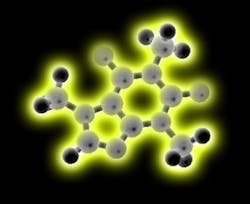'Glowing' detectors could visually ID toxins or pathogens
Researchers at MIT (Cambridge, MA) have developed an approach that pairs fluorescent molecules with an open scaffolding called a metal-organic framework (MOF), enabling them to reveal presence of specific toxins, disease markers, pathogens, or explosives. Their MOF structure provides lots of open space for target molecules to occupy, bringing them into close proximity with fluorescent molecules that react to their presence. Then, their system visually signals the presence of a target chemical by emitting a fluorescent glow.
The work could have significant applications in sensors attuned to specific compounds whose detection could be read at a glance simply by watching for the material to glow. Assistant professor of chemistry Mircea DincÄ, who led the work, notes that a lot of known sensors "turn off" in the presence of the target compound; therefore, sensors that "turn on" are better because theyâre easier to detect and the contrast is better.
If the material is tuned to detect carbon dioxide (CO2), for example, the deviceâs readout is much more obvious with more CO2 present. And itâs not just the presence or absence of a specific type of molecule: the system can also respond to changes in the viscosity of a fluid, such as blood, which can be an important indicator in diseases such as diabetes. In such applications, the material could provide two different indications at onceâfor example, changing in color depending on the presence of a specific compound, such as glucose in the blood, while changing in intensity depending on the viscosity.
MOF materials' inner pores measure about one nanometer across and equate to the size of a small molecule, making them well suited as molecular detectors, says DincÄ. The new material is based on the MIT teamâs discovery of a way to bind a certain type of fluorescent molecules, also known as chromophores, onto the MOFâs metal atoms. While these particular chromophores cannot emit light by themselves, they become fluorescent when bunched together. When in bunches or clumps, however, target molecules cannot reach them and therefore cannot be detected. Attaching the chromophores to nodes of the MOFâs open framework keeps them from clumping, while also keeping them close to the empty pores so they can easily respond to the arrival of a target molecule.
The MIT approach still needs further refinement to improve the efficiency of production, which should be easily accomplished, says Ben Zhong Tang, a professor of chemistry at the Hong Kong University of Science and Technology, who was not involved in the work. Once that is achieved, he says, it could find many uses, such as smart vehicles and monitors for controlled drug deliveries. What's more, the fluorescence should be gradually weakened in intensity along with progressive release of the drugs, enabling in situ real-time monitoring of the drug release profiles, he says.
Published online in the Journal of the American Chemical Society, the work was supported by MITâs Center for Excitonics, an Energy Frontier Research Center funded by the U.S. Department of Energy, and by the National Science Foundation. For more information, please visit http://pubs.acs.org/doi/abs/10.1021/ja209327q.
-----
Follow us on Twitter, 'like' us on Facebook, and join our group on LinkedIn
Follow OptoIQ on your iPhone; download the free app here.
Subscribe now to BioOptics World magazine; it's free!
